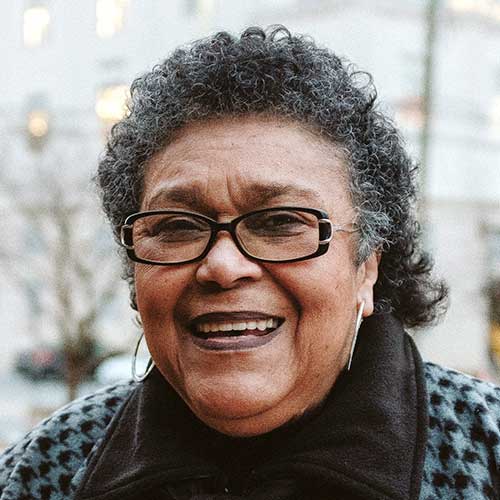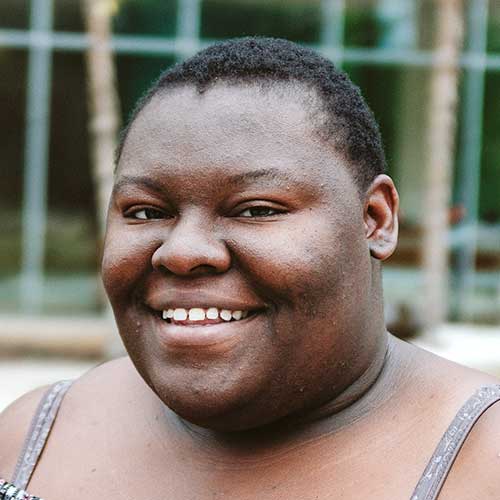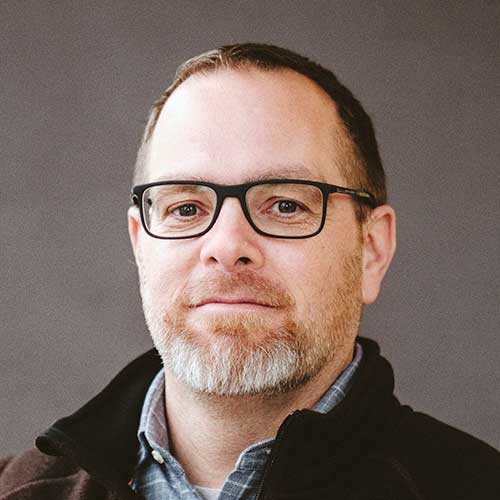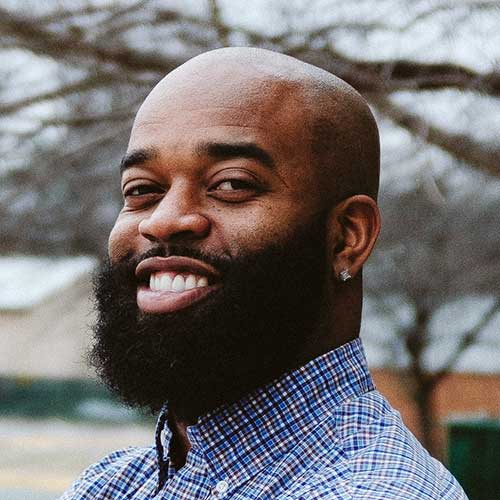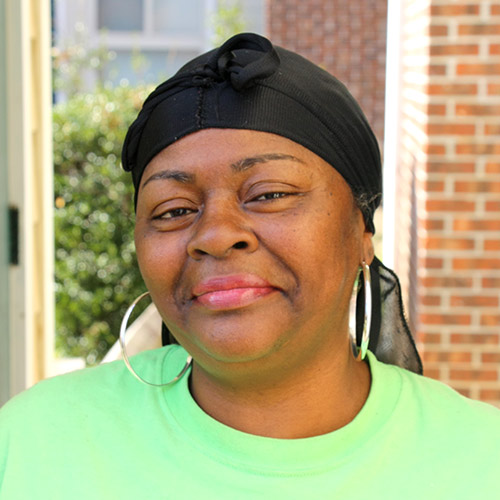How Did We Get Here?
For 25 years, before its name was changed to Friendship Court — in an effort to redefine it — it was called Garrett Square. And to many, like Mary Carey, it will always be Garrett Square. Carey was one of the first families to move into the neighborhood after it was built in 1978. She’s 72 years old and has spent much of her life in the Garrett Street area, raising three boys there. Today, she lives just a couple blocks away from Garrett Square, and through her living room window she can see the neighborhood changing — 9-story high rises are being built, million-dollar condos are being sold, and dozens of businesses are offering goods and services that are unaffordable for the 500 residents at its core.
As a kid, Carey remembers walking to Allen’s Store , the neighborhood grocer opened by Kenneth and Dorothy Allen in 1944 on the corner of Sixth Street SE and Garrett Street.
“My mom used to go down there and get all her side meat,” says Carey. “Mr. Allen’s brother was my cousin's father so…he used to give my mom a little discount because she had six kids.” Carey also recalls delivering newspapers with her sister on Bell Street, on Alto Street, on Cook Street. She remembers when Ware Street used to stretch all the way from Elliott Avenue to Garrett Street.
None of this exists any longer. After 34 years of business, Allen’s Store was forced to move, as were the Allen family and hundreds of others who called the area home. In the early 1970’s, the Charlottesville Redevelopment Housing Authority (CRHA) assessed 184 properties in the area, about 80 percent of them residential homes that black families either owned or rented at affordable rates.
“‘Urban Removal’ was coming in and they were taking all the black neighborhoods and just destroying them.”
— Mary Carey
After a series of narrowly-passed citywide votes that required voters to pay a poll tax and allowed for the destruction of Vinegar Hill, another African-American neighborhood, CRHA paid owners the market-value, seized their properties under eminent domain, and bulldozed the Garrett Street neighborhood . It was part of a larger, white-led, effort to push black families out of the city’s central downtown areas by condemning their neighborhoods as “slums” or “blighted,” while arguing that their presence was hurting the city’s tax base. But, as evidenced in CRHA records, homes in the Garrett Street area were not “slums” or “blighted.” In 1969 , according to records, the CRHA assessed them as valuing a total of $2.1 million — adjusted for inflation, this would be $14.8 million today. “‘Urban Removal’ was coming in and they were taking all the black neighborhoods and just destroying them,” says Carey.
All this was done in the name of redevelopment, or “revitalization” as they called it then. But, Mayor Nikuyah Walker asks, redevelopment ‘of what?’ And redevelopment ‘for whom?’ In Charlottesville, like most of the country, the wealthy have traditionally controlled what gets built, where it gets built, how it gets built, and for whom it gets built. The non-profit Piedmont Housing Alliance (PHA), which owns the 12-acre Friendship Court property, is trying to alter that historical model by putting current residents, whose average income is $14,000 a year, in the driver’s seat, letting them shape the details of their future neighborhood. But Walker worries this may not be enough to repair historical inequities and set a new path forward.
Friendship Court’s redevelopment plan proposes moving between 75 and several hundred households who make more than $65,000 a year into the neighborhood. Everyone agrees, this will significantly change the fabric of the area, which over the last decade has already seen an influx of high-income residents move in, across the street in the Gleason and NorCross Station buildings. Many people, including Friendship Court residents, are pushing for this change, saying it could help improve their access to resources and opportunities. Walker agrees with these goals, but she questions whether this is the best way to accomplish them. She worries this approach may avoid the harder conversation about actually undoing and changing the lasting effects of historic racism still at work today.
“I think you let the people who have put these policies in place — who created the kind of environment where people don't thrive, that they only survive — you let them off the hook, because [you’re saying] that we can't live amongst ourselves and be happy and successful if we are all black, or all low income,” says Walker. “That is letting off the hook the power structures in this country, and clearly in this city, that have created the environment where crime happens, drug addiction and abuse happens, anything that leads up to trauma happens. And we all know that [with] more poverty, the more those things are exacerbated.”
Walker says Friendship Court residents shouldn’t have to get wealthier neighbors in order for their quality of life to improve, and she’s advocating for the removal of the systems and barriers that have prevented low-income people from having these resources in the first place. This will require re-evaluating how business is traditionally done, she says, and seriously looking at the city’s history from a generational perspective : how racially restrictive housing policies prevented black families from accumulating wealth and then evolved into modern-day exclusionary zoning policies — how the racist redlining practices by banks of the 1960’s and 70’s were never halted for residents with a Garrett Street address — how the city-enforced war on drugs and the criminalization of poverty and addiction gave birth to the under-resourced modern family unit experienced by many low-income residents today — how prioritizing education and employment opportunities by white middle- and upper-income families have excluded many black families. To understand what we must undo and repair, Walker says, we must better understand how we got here.
Businesses that surround Friendship Court today do not employ many of the residents who live in Friendship Court. Instead, most residents work in other parts of the city, and the businesses near their homes tend to hire people who live further away. Friendship Court residents say it sends them the message that either they’re not good enough to work in these businesses or they’re not wanted. But fifty years ago, the Garrett Street area was on the edges of the city’s industrial corridor, and Mary Carey’s uncle, like many others, would walk to work just a stone’s throw away at the Elliot Ice Company (formerly the Charlottesville Ice Company). On Sundays he’d get a gallon of ice cream from the company to share with the family, and Carey recalls, he’d let her pick out the flavor. Across the street from where ACAC is today, Carey remembers workers herding cattle through corrals to be put on the train and brought to slaughter. A block to the east, across from her uncle’s place, was Charlottesville’s most infamous brothel, Miss Marguiretta’s house, where white police officers, city officials, and University of Virginia students were frequently seen.
These were the same white city residents who benefited from racially restrictive covenants that gave them unchallengeable ownership of thousands of the most valuable single-family homes built in the city from 1900 to 1950. In 1928 , for example, newly built racially restricted houses routinely sold for $2,000 in North Downtown, only $400 of which had to be paid in cash, a hefty but doable sum for working-class families, black or white, at that time. (Adjusted for inflation, that’s $29,137 with $5,827 paid in cash.) Forty-five years later, in the 1970s, these same homes frequently passed to the owners’ adult children to be sold for about $34,000. (Adjusted for inflation, that’s $208,498.) Not taking into consideration the ability to use the home as collateral for additional lines of credit, this amounted to $179,361 in accumulated wealth for these white families. These same homes are worth more than $600,000 today.
“People in white public housing were getting subsidies to buy homes in the suburbs. And so, to fill up those [empty public housing] units, African-Americans backfilled them. And so now, public housing is primarily minority. And unfortunately, we tend to see neighborhood segregation as naturally occurring, but in this country, it’s anything but.”
— Dan Rosensweig
These racial restrictions were enforced during the height of Jim Crow, when white and black people had separate businesses, schools, and neighborhoods. But often overlooked in these ‘separate but equal’ practices is that city funding and resources were also separate, but frequently unequal — that is, disproportionately allocated to white businesses, white schools, and white neighborhoods. As these are the central tenants to accumulating generational wealth in this country, these practices allowed for the emergence and solidification of a white middle and upper class. And these were not isolated incidents, but rather, they were citywide endeavors carried out and approved with the complicity of government officials, realtors, bankers, lawyers, homeowners, urban planners, and developers.
“Now, it is being linked more with a social justice framework and a racial justice framework.”
— Liz Ogbu
Legal challenges mounted over the years, and eventually, in 1948, the Supreme Court ruled racially restrictive covenants unenforceable. But then, as executive director of Habitat for Humanity of Greater Charlottesville Dan Rosensweig says, the Federal Housing Administration financed a gigantic housing boom, lending millions of dollars to first-time home buyers, but only if they were white. “So all of a sudden we're taking housing policy, during the single greatest expansion of our housing supply in the country, and we're making it only available to white people,” Rosensweig says, noting that public housing at the time was also segregated by race. “People in white public housing were getting subsidies to buy homes in the suburbs. And so, to fill up those [empty public housing] units, African-Americans backfilled them. And so now, public housing is primarily minority. And unfortunately, we tend to see neighborhood segregation as naturally occurring, but in this country, it’s anything but. We’ve created policy that…has made our communities by-and-large segregated.”
White families, although in the minority, used to live next door to black families in the Garrett Street area, according to property records. But long after Jim Crow practices were supposedly discontinued, the idea of black families living next door to white people in majority-white neighborhoods was still almost entirely nonexistent here. In the 1960’s a group of white and black civil rights advocates formed Charlottesville’s Fair Housing Committee , and followed up on more than 70 advertisements in the Daily Progress by white realtors and homeowners trying to sell homes. Only one said they would be willing to sell to an African-American family. The committee took notes of each call and the responses they received. One reads: “Mr. Michael would not be willing to talk to a Negro buyer. He says he’s afraid the neighbors would shoot him.” Another reads: “Mrs. Ashcom says the owner is in Florida but she is certain the owner would not be willing to show the house to a Negro buyer as it would cause an uproar.”
These housing policies restricted where black families could move, which limited their accumulation of wealth. Combined with restrictive educational and employment opportunities by white-led businesses and institutions — where the white employees were the ones to get jobs, promotions, and advanced level placements — a black family’s ability to increase their income was severely limited. The effect of this is still felt today in historically black neighborhoods. Last fall, a team of national researchers and federal employees took census data and created the Opportunity Atlas.
Not only did it find overwhelming disparity in life outcomes between black and white children on nearly every level in Charlottesville, it also got specific, finding that black children who grow up in Friendship Court can expect to make between $20,000-$26,000 a year when they reach adulthood. But if they live just four blocks to the north, in North Downtown, they can expect to see their income increase by $3,000-$12,000 (for a total of $23,000-$32,000 a year). Neither of these annual incomes is considered an actual living wage here — the Orange Dot 3.0 report issued last fall determined it takes a minimum of $35,000 a year to live in Charlottesville without any subsidies (one in four families in Charlottesville do not earn this much). But the data show that where people live has a direct effect on life outcomes and can in fact predict their future.
And it’s not just income. The study found that 8.5 percent of black children in Friendship Court — nearly one in ten — would be incarcerated as adults, whereas just four blocks north, less than 1 percent of white children would be. And this is not by accident. In 1992, led by reporter Bob Gibson, the Daily Progress published a year-long six-part investigative series entitled “Separate Justice” that looked at the rates African-Americans were being arrested, placed on probation, and incarcerated. It found that from 1989 to 1991, 75 percent of everyone convicted of a felony in Charlottesville was black. African-Americans only made up 21 percent of the population at that time. The series pointed to two causes: the racially targeted crack-cocaine sentencing disparity, and a lack of adequate legal representation for people in poverty. In 1998, the newspaper investigation led to the creation of a public defender’s office in Charlottesville, which had not before existed.
As if to send the message home further for residents in Garrett Square, it was around this time, in 1996, that a giant 7-foot tall black gate was erected around the property, cordoning off neighbors from one another, disconnecting natural pathways, and forcing residents to wonder: are they trying to keep crime out, or keep us in? This reality of disproportionate minority contact, as it’s called, has not ceased. Over the last five years, Charlottesville data show that police and law enforcement continue to stop and frisk, arrest and incarcerate black people at a disproportionately higher rate than white residents.
“Assimilate, and then [drive] out those who don't or can’t,” says Walker. “It’s not something that's natural — you have to give up everything about you to fit into someone else's culture — to be able to live, to be able to stay in this town. That should be an unacceptable request, [but] we haven't created an environment where that is unacceptable.”
— Nikuyah Walker
Pointing to this city history, including those of black codes, Jim Crow laws, school integration policies, urban renewal practices, and racially disproportionate incarceration, Walker says she sees the push to bring wealthier neighbors into Friendship Court as yet another attempt to force low-income black residents to assimilate to the norms and cultural practices accepted by higher-income white populations, if they want to succeed in life.
“Assimilate, and then [drive] out those who don't or can’t,” says Walker. “It’s not something that's natural — you have to give up everything about you to fit into someone else's culture — to be able to live, to be able to stay in this town. That should be an unacceptable request, [but] we haven't created an environment where that is unacceptable. So that is what the ask [is]…for families who are low-income to be able to stay, and that's unacceptable. I mean, it should be unacceptable, but it's not. Because we haven't arrived at that place where people are questioning themselves [enough] to even ask, ‘Is that what I'm asking people to do — let go of who they are, to live next to me?’ That's not what people are thinking…but that's exactly what they're asking: Give up everything about yourself, so I can accept you.”
